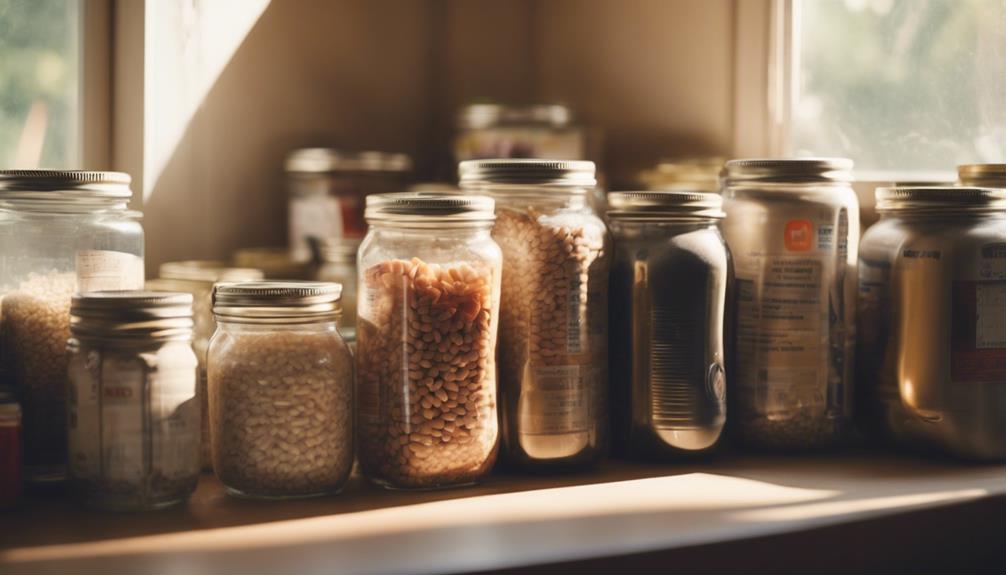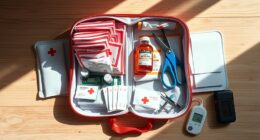In an outage, keeping your temperature regulated is essential. For the cold, dress in layers, insulate windows with heavy curtains, and block drafts with towels or blankets. Conserve heat by staying in small, insulated spaces and using sleeping bags. When it's hot, wear light, breathable clothing and stay hydrated. Use cold compresses to cool down and find the coolest spots in your home. Always stay informed about local resources like cooling stations. With the right strategies, you'll stay comfortable, no matter the weather. Discover more tips on how to stay safe and cozy during power outages. Plan ahead by stocking up on emergency supplies such as non-perishable food, water, flashlights, and batteries. It’s also important to have a backup power source like a generator or solar-powered charger for essential devices. Additionally, make sure to familiarize yourself with home safety during outages, such as how to safely use alternative heating sources and how to properly handle and store food during extended power outages. By being prepared and informed, you can ensure your comfort and safety during any outage.
Key Takeaways
- Insulate your home by sealing gaps around windows and doors to prevent cold drafts and retain heat during outages.
- Dress in layers with moisture-wicking materials to maintain warmth and cover extremities to minimize heat loss.
- Use household items like blankets and towels to block drafts and enhance insulation in your living space.
- Stay hydrated and prepare warm drinks to help regulate body temperature during extreme heat or cold.
Safety Precautions for Outages
When the power goes out, it's vital to take safety precautions to protect yourself and your loved ones from potential hazards. One of the biggest risks during a power outage is carbon monoxide poisoning. Always use battery-powered generators outdoors and follow safety instructions to avoid dangerous fumes. Never operate gas stoves, ovens, or grills indoors for heat, as this can lead to harmful carbon monoxide buildup.
To keep warm, dress in layers made of moisture-wicking materials. Make sure your extremities are covered with hats, gloves, and warm socks. You can also block drafts by sealing doors and windows with towels or clothing. Insulating floors with blankets helps conserve heat, making a significant difference in colder temperatures.
Installing carbon monoxide detectors is another important safety precaution. They provide early warnings of hazardous conditions, making certain you're alerted to any potential dangers during a power outage. By following these safety measures, you not only protect yourself from the cold but also from the hidden risks that come with sudden outages.
Stay safe and prepared, so you can weather any storm without unnecessary worry.
Effective Insulation Techniques

When you're facing an outage, effective insulation techniques can make a big difference in keeping your space warm.
You can focus on draft prevention strategies, layer materials for maximum insulation, and utilize household items to block cold air.
Let's explore how these simple actions can help you maintain a comfortable temperature during tough times.
Draft Prevention Strategies
To keep your home warm during an outage, sealing gaps around doors and windows is essential for preventing cold drafts from sneaking in.
These draft prevention strategies can notably reduce heat loss and make your space more comfortable. Here are three effective techniques to insulate your home:
- Seal Gaps: Use towels or clothing to block cold air from entering through cracks around windows and doors. This simple step can dramatically improve your home's warmth.
- Insulate Windows: Heavy curtains, bubble wrap, or plastic sheeting can create an extra barrier against cold air. By covering your windows, you can better retain indoor warmth.
- Close Off Unused Rooms: By shutting doors to areas you're not using, you concentrate heat in smaller spaces, making it easier to maintain a cozy environment.
Additionally, don't forget to lock your windows to make sure they press tightly into the frame, minimizing heat loss.
Using rugs or newspapers can also insulate floors against cold drafts.
Layering for Maximum Insulation
Layering your clothing effectively traps air and creates a barrier against heat loss, making it vital for staying warm during an outage.
Start with a moisture-wicking base layer, like thermal underwear made from synthetic fabrics such as polyester or nylon. This layer pulls moisture away from your skin, keeping you dry and comfortable, which is essential for maintaining body heat.
Next, add an insulating mid-layer. Materials like fleece or wool are excellent choices, as they retain warmth and provide additional insulation. The combination of these layers helps to keep your body heat from escaping.
Don't forget to cover your extremities! Wearing thick socks, gloves, and a hat can greatly enhance your warmth since these areas tend to lose heat quickly.
In extreme cold, consider crumpling paper or packing materials and placing them between your layers of clothing. This simple trick increases insulation without adding bulk.
Remember that insulating your living space by closing off unused rooms and blocking drafts can further complement your layered clothing strategy, ensuring you stay warm and comfortable during power outages.
Utilizing Household Materials Effectively
Utilizing everyday household materials can greatly enhance your home's insulation during an outage, helping you retain warmth more effectively. By employing simple techniques, you can minimize heat loss and keep your living space comfortable.
Here are three effective methods:
- Insulate Windows: Use bubble wrap, plastic sheeting, or heavy curtains to cover your windows. These materials act as barriers, considerably reducing heat loss and ensuring your indoor temperature remains stable.
- Block Drafts: Tackle cold air by sealing gaps around doors and windows with towels, clothing, or blankets. This simple step can effectively block drafts and prevent chilly air from entering your living spaces.
- Cover Floors: Lay down heavy rugs or even crumpled newspapers to provide insulation against cold drafts from the ground. This helps retain warmth in the room, making it cozier and more inviting.
Managing Indoor Activities

Gather your family or friends in a small, insulated room to create a cozy atmosphere and retain warmth during the outage. This setup helps trap body heat, making it easier to stay warm.
Engage in indoor activities like board games, storytelling, or reading to lift spirits and foster togetherness. These activities not only distract from the discomfort but also strengthen bonds as you share the experience.
Don't forget to prepare hot drinks like tea or cocoa. Sipping on these beverages provides warmth and hydration, which is essential in both cold and hot conditions. You can also use blankets and sleeping bags to enhance comfort, layering your clothing to prevent heat loss.
If the outage occurs during warmer weather, limit physical activity to avoid overheating. Instead, consider using battery-operated fans to circulate air and maintain a more comfortable environment.
Staying Informed During Outages

Staying informed during outages is essential for your safety and preparedness. When power outages strike, knowing what's happening around you can help with temperature regulation and staying warm or cool.
Here are three key ways to stay updated:
- Tune into local news: Use battery-powered devices to catch updates on radio or television. They'll provide critical information about restoration efforts and weather conditions.
- Sign up for emergency alerts: Local authorities often offer notifications about severe weather and safety information. These alerts can help you prepare effectively for unexpected power outages.
- Share information with neighbors: Collaborate with your community. Sharing resources and updates can enhance everyone's safety, ensuring that no one is left in the dark during outages.
Preparing for Future Outages

As you prepare for future outages, having an emergency kit ready is vital.
You'll want to include items like flashlights, batteries, and first aid supplies to guarantee your family stays safe and comfortable.
Additionally, consider community preparedness strategies to enhance your overall readiness and support each other during emergencies.
Emergency Kit Essentials
An effective emergency kit is fundamental for ensuring your safety and comfort during power outages. You'll want to prepare for various conditions by including significant items that keep you hydrated, warm, and informed. Here are three must-have essentials for your emergency kit:
- Water: Store at least one gallon of water per person per day for at least three days. This is essential for staying hydrated.
- Blankets or Sleeping Bags: These provide warmth and comfort, helping you maintain your body temperature when it's cold.
- Battery-Powered Radio: Stay updated on weather conditions and emergency alerts, ensuring you can respond effectively.
Additionally, don't forget to include non-perishable food items that don't need cooking, essential medications, first aid supplies, and personal hygiene products.
Flashlights with extra batteries are important for lighting up your space, while candles and waterproof matches can help in maneuvering through the dark.
A multi-tool or utility knife adds versatility to your kit.
Community Preparedness Strategies
Effective community preparedness strategies can considerably reduce the impact of future power outages, guaranteeing everyone stays safe and informed.
Start by establishing a community emergency communication plan. This will help share real-time information about outages and available resources during extreme weather events.
Organizing local preparedness workshops is also crucial; they teach residents how to create effective emergency kits, utilize alternative heat sources, and maintain food safety during outages.
Collaboration with local authorities is essential to identify and promote designated warming and cooling centers. These centers can provide shelter and resources for those in need during extreme temperatures.
Encourage neighbors to check on each other, particularly vulnerable populations like the elderly, to guarantee they've access to necessary supplies and support.
Strategies to Beat the Heat

Stay cool during a power outage by sipping on water and electrolyte-rich drinks to keep your body hydrated and avoid overheating. Here are three effective strategies to help you beat the heat and regulate your body temperature:
- Use Cold Compresses: Apply cold compresses to your head and neck. This simple trick helps to lower your temperature quickly.
- Find the Coolest Spot: Move to the coolest areas of your home. Open windows during the early morning or evening for better air circulation.
- Dress Appropriately: Wear light, loose-fitting clothing made from breathable materials. This helps minimize heat retention and allows your body to stay warm without overheating.
Staying hydrated is key, so avoid ice-cold drinks; they're less effective at cooling you down.
Remember, it's vital to stay informed about local cooling stations, especially during extreme heat events. These stations can provide air conditioning and hydration options that are life-saving for vulnerable populations.
Health Risks From Temperature Extremes

Extreme temperatures pose considerable health risks, making it crucial to recognize the dangers of both heat and cold exposure. During heat waves, you can experience heat exhaustion, which involves heavy sweating, nausea, and confusion. Vulnerable groups, like the elderly, are particularly at risk, so it's important to have ways to stay cool. On the flip side, cold temperatures can lead to hypothermia and frostbite, both of which require immediate medical attention.
To highlight the risks associated with temperature extremes, consider the following:
| Temperature Extreme | Health Risks |
|---|---|
| Extreme Heat | Heat exhaustion, heatstroke |
| Extreme Cold | Hypothermia, frostbite |
| Symptoms | Shivering, confusion |
| Prevention | Drink cold drinks, stay warm |
Recognizing these risks can help you take precautions. Always monitor local weather updates and advisories. During extreme heat, stay hydrated with cold drinks and find ways to cool down. In cold weather, make sure you have adequate clothing and shelter to stay warm. Keeping these factors in mind can greatly reduce health risks during outages.
Utilizing Household Resources

Utilizing everyday household resources can help you maintain warmth and safety during power outages. You don't have to rely solely on external heat sources; instead, you can make the most of what you have at home. Here are three effective ways to keep your house warm:
- Insulate Windows and Doors: Use crumpled paper or packing material to block drafts. This simple step can greatly improve heat retention indoors.
- Chemical Hand Warmers: These handy tools can provide localized heat for your hands, feet, or even baby bottles. They're perfect for keeping warm when the temperature drops.
- Mylar Space Blankets: Lightweight and reflective, these blankets trap body heat effectively. Wrap one around yourself or use it as a cover to stay cozy.
Additionally, you can use candles for light and mild heat, but remember to keep them safe.
Community Support and Resources

When an outage hits, knowing where to find local cooling stations can make a huge difference in your comfort and safety.
You'll also want to stay connected through emergency communication networks to receive timely updates on available resources.
Local Cooling Stations
Local cooling stations offer a critical refuge from oppressive heat, providing air conditioning, water, and shade for those in need during power outages. These stations become indispensable during heat waves, especially for vulnerable populations like the elderly or anyone lacking proper home cooling.
Here are three key benefits of using local cooling stations:
- Comfort and Safety: Stay cool and hydrated while escaping the sweltering heat.
- Community Engagement: These stations often host activities and resources, helping you connect with others during extreme weather.
- Accessibility: Open during peak heat hours, they're easy to find through local government resources or emergency management websites.
Understanding the locations and operational hours of these local cooling stations can greatly enhance your safety and comfort during heat waves.
Emergency Communication Networks
Establishing an emergency communication network is crucial for guaranteeing you and your neighbors stay informed and supported during power outages. A well-thought-out communication plan can make all the difference when facing unexpected challenges.
| Method | Purpose | Notes |
|---|---|---|
| Local Social Media | Real-time updates | Join community groups |
| Emergency Hotlines | Critical information | Register with local authorities |
| Community Shelters | Temporary refuge | Know locations and hours |
| Volunteer Networks | Resource distribution | Collaborate for preparedness |
Utilizing local social media groups and community apps helps you stay connected with updates on power restoration efforts and support coordination. Local authorities often set up emergency hotlines or text alert systems, so make certain to register for these services. Additionally, knowing the locations and operating hours of community shelters can provide crucial support during extreme weather events. By collaborating with local organizations and volunteer groups, you can create a robust emergency preparedness network that addresses the needs of vulnerable populations during outages. Stay proactive, and guarantee you're ready to help each other through tough times.
Community Resource Sharing
Community resource sharing plays an essential role in ensuring everyone has access to vital support during power outages, especially for those who may be more vulnerable. By leveraging local communication networks, you can quickly connect with neighbors and coordinate efforts to keep everyone safe and comfortable.
Here are three key ways to engage in community resource sharing:
- Establish Neighborhood Groups: Form or join local groups that can organize the distribution of emergency supplies like food, blankets, and heating equipment.
- Utilize Community Centers: Make use of local community centers as warming or cooling stations where residents can find shelter, refreshments, and a place to charge devices.
- Leverage Social Media: Share real-time updates on available resources and assistance programs through social media platforms to keep everyone informed.
Emergency Kits and Supplies

An effective emergency kit is crucial for staying safe and comfortable during power outages, especially in extreme temperatures. You need to be well-prepared to guarantee your family's safety. Here's a checklist to help you create a thorough emergency kit:
| Item | Quantity | Purpose |
|---|---|---|
| Water | 1 gallon per person/day | Hydration |
| Non-perishable food | 3-day supply | Nutrition |
| Blankets | 2-3 per person | Warmth during cold outages |
| Flashlight | 1-2 | Light source |
| NOAA Weather Radio | 1 | Weather updates & alerts |
Be sure to have a first aid kit, extra batteries, and a multi-tool handy. Keep warm clothing, sleeping bags, and a list of important medical information in your kit. This way, you'll have everything you need to stay comfortable and informed during an outage. Preparing your emergency kit now can make all the difference when faced with unexpected power loss. Don't wait until it's too late!
Conclusion
In an outage, keeping your home comfortable can be a challenge, but with the right strategies, you can beat the heat or cold.
Did you know that extreme temperatures can increase the risk of heat-related illnesses by 30%?
By insulating your space, managing activities, and staying informed, you can protect yourself and your loved ones.
Remember to prepare for future outages and tap into community resources for support.
Stay safe and stay comfortable!










